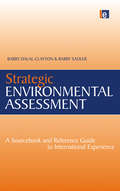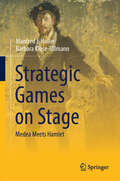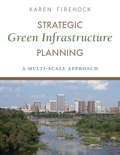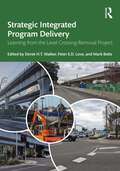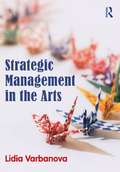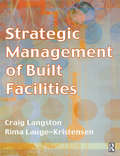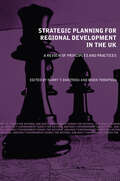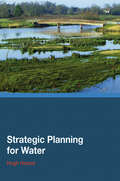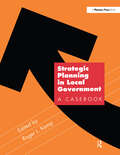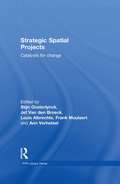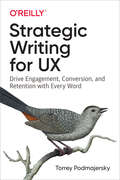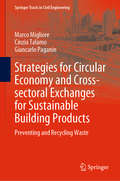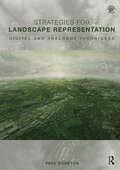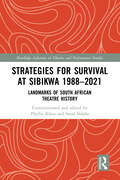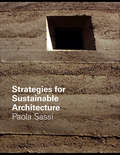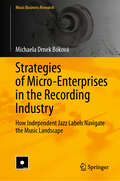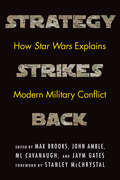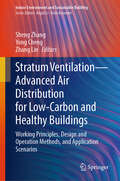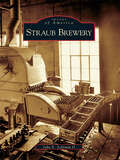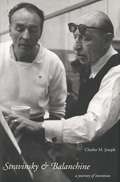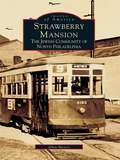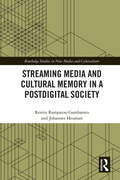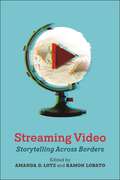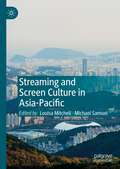- Table View
- List View
Strategic Environmental Assessment: A Sourcebook and Reference Guide to International Experience
by Barry Sadler Barry Dalal-ClaytonThis unique sourcebook provides a global, state-of-the-art review of the rapidly evolving field of strategic environmental assessment (SEA) that is intended to serve as a baseline for the work of an OECD Task Team on SEA and a UNEP initiative on integrated planning and assessment. It describes trends in application and experience in different contexts worldwide, providing in-depth coverage of the status of SEA systems, and practice in developed, transitional and developing countries by a range of development agencies. The book draws on a large body of published and unpublished material, and contributions from a wide range of individual experts, organizations and agencies. It provides an unparalleled and invaluable understanding of the emerging scope and potential of SEA and describes how, when and where it is being used. The sourcebook includes a probing review of concepts, terminology, approaches and tools of SEA, and a comparative analysis of the different types of existing SEA systems. The volume also contains many case examples illustrating SEA practice in different countries and contexts, a full set of references and a number of appendices containing source materials.
Strategic Games on Stage: Medea Meets Hamlet
by Manfred J. Holler Barbara Klose-UllmannThis book illustrates how strategic thinking and game theory can be applied to study and enjoy theater plays. By offering various case studies on plays such as Antigone, Medea, Hamlet, Schiller’s Wallenstein, Ibsen’s Hedda Gabler, Tennessee Williams’ A Streetcar Named Desire, Arthur Miller’s The Crucible, and Elfriede Jelinek’s Rechnitz, the authors analyze the dynamics of player choices, including their misperceptions, deceptions, and various power games. Plays are examined according to their strategic contexts and, if appropriate, analyzed by means of game theory. This book is written for anyone interested in theater and who wants to learn about strategic behavior on stage but also for readers who are looking for an exciting field for applying game theoretical reasoning.
Strategic Green Infrastructure Planning: A Multi-Scale Approach
by Karen FirehockFrom New York City's urban forest and farmland in Virginia to the vast Sonoran Desert of Arizona and riverside parks in Vancouver, Washington, green infrastructure is becoming a priority for cities, counties, and states across America. Recognition of the need to manage our natural assets--trees, soils, water, and habitats--as part of our green infrastructure is vital to creating livable places and healthful landscapes. But the land management decisions about how to create plans, where to invest money, and how to get the most from these investments are complex, influenced by differing landscapes, goals, and stakeholders. Strategic Green Infrastructure Planning addresses the nuts and bolts of planning and preserving natural assets at a variety of scales--from dense urban environments to scenic rural landscapes. A practical guide to creating effective and well-crafted plans and then implementing them, the book presents a six-step process developed and field-tested by the Green Infrastructure Center in Charlottesville, Virginia. Well-organized chapters explain how each step, from setting goals to implementing opportunities, can be applied to a variety of scenarios, customizable to the reader's target geographical location. Chapters draw on a diverse group of case studies, from the arid open spaces of the Sonoran Desert to the streets of Jersey City. Abundant full color maps, photographs, and illustrations complement the text. For planners, elected officials, developers, conservationists, and others interested in the creation and maintenance of open space lands and urban green infrastructure projects or promoting a healthy economy, this book offers a comprehensive yet flexible approach to conceiving, refining, and implementing successful projects.
Strategic Integrated Program Delivery: Learning from the Level Crossing Removal Project
by Mark Betts Walker, Derek H.T. Love, Peter E.D.This book outlines a cutting-edge form of program delivery which the authors term SIP-Form or Strategic Integrated Program delivery. Using the Melbourne Level Crossing Removal Program (LXRP), consisting of the removal of 85 dangerous level crossings throughout metropolitan Melbourne, including rail station upgrades, signalling and track work, and other associated capital works, as an exemplar, the book sets out four features that the authors argue define the SIP-form concept as follows: The organisation delivers a program of projects, many using an IPD contract variant form such as a Project Alliance Agreement (PAA) in Australia and numerous other countries, or the Integrated Form of Agreement (IFoA) in North America The contract form adopted is used and has been strategically designed to accommodate the project’s risk and uncertainty profile, as is the case with the LXRP Projects within the program are integrated with some being concurrently delivered with coordination across the projects in a coherent and highly purposeful manner. Projects are not included that do not strategically fit the overall program delivery strategy There is a strategy for learning and innovation diffusion across projects, concurrently and sequentially. Lessons to be learned are learned through designed-in governance mechanisms The LXRP is a potentially unique program of projects, and the book takes the reader on a journey through this complex program and after giving the background and relevant context covers topics such as strategy, governance, procurement, collaboration, program alliance, HRM, leadership, digital innovation, continuous improvement, community engagement, and performance measurement. This detailed analysis of such a complex program of projects makes this book essential reading for project managers, engineers, and advanced students of project delivery and management.
Strategic Management in the Arts
by Lidia VarbanovaStrategic Management in the Arts looks at the unique characteristics of organisations in the arts and culture sector and shows readers how to tailor a strategic plan to help these diverse organizations meet their objectives. Strategic management is an essential element that drives an organisation’s success, yet many cultural organizations have yet to apply strategic thinking and entrepreneurial actions within the management function. Varbanova reviews the existing theories and models of strategic management and then relates these specifically to cultural organisations. Also included are sections on entrepreneurship and innovations in the arts, considering the concept of a ‘learning organisation’ – an organisation able to adapt its strategy within a constantly changing, complex environment. The book is structured to walk the reader through each element of the strategic plan systematically. With a fresh approach, key questions, examples, international cases to connect theory with practice and suggestions for further reading, this book is designed to accompany classes on strategic planning, cultural management or arts management.
Strategic Management of Built Facilities
by Craig Langston Rima Lauge-KristensenThe effective management of facilities can significantly improve business productivity. In this textbook the authors provide an overview of facility economics and outline the way in which businesses and facility managers can get better value from their physical assets.Students on facilities management and property related degrees will find this an invaluable introduction.
Strategic Planning for Regional Development in the UK (Natural and Built Environment Series)
by Harry T. Dimitriou Robin ThompsonWith contributions from leading academics and practitioners, Strategic Planning for Regional Development in the UK is the most up-to-date treatment of a fast-changing subject. The book discusses: The evolution of regional planning in the UK and the strategic thinking involved The spatial implications of regional economic development policies The methods and techniques needed for the implementation of strategic planning for regional development How strategic planning for regional development is currently put into practice in three UK regions with different priorities. Strategic Planning for Regional Development in the UK is essential reading for students and academics working within strategic and regional planning and provides policy makers and practitioners with a comprehensive and thought provoking introduction to this critically important emerging field.
Strategic Planning for Water
by Hugh HowesStrategic Planning for Water examines the neglected relationship between planning for water and spatial planning. It provides the background to sustainable water management and assistance to spatial planners in understanding the complex water environment. This extremely topical book examines the challenges of:how to ensure that water supplies are a
Strategic Planning in Local Government: A Casebook
by Roger KempThis book shows how and why strategic planning is working in cities around the country. It illustrates how this technique enables a city to plan its future proactively and shows how local governments use it to solve current problems and make sure they continue to reach their goals. Using seventeen case studies from a diverse mix of cities, it outli
Strategic Spatial Projects: Catalysts for Change (RTPI Library Series)
by Stijn Oosterlynck Louis Albrechts Frank Moulaert Jef Van Den Broeck Ann VerhetselStrategic Spatial Projects presents four years of case study research and theoretical discussions on strategic spatial projects in Europe and North America. It takes the position that planning is not well equipped to take on its current challenges if it is considered as only a regulatory and administrative activity. There is an urgent need to develop a mode of planning that aims to innovate in spatial as well as social terms. This timely, important book is for spatial planning, urban design and community development and policy studies courses. For academics, researchers and students in planning, urban design, urban studies, human and economic geography, public administration and policy studies.
Strategic Writing for UX: Drive Engagement, Conversion, and Retention with Every Word
by Torrey PodmajerskyWhen you depend on users to perform specific actions—like buying tickets, playing a game, or riding public transit—well-placed words are most effective. But how do you choose the right words? And how do you know if they work? With this practical book, you’ll learn how to write strategically for UX, using tools to build foundational pieces for UI text and UX voice strategy.UX content strategist Torrey Podmajersky provides strategies for converting, engaging, supporting, and re-attracting users. You’ll use frameworks and patterns for content, methods to measure the content’s effectiveness, and processes to create the collaboration necessary for success. You’ll also structure your voice throughout so that the brand is easily recognizable to its audience.Learn how UX content works with the software development lifecycleUse a framework to align the UX content with product principlesExplore content-first design to root UX text in conversationLearn how UX text patterns work with different voicesProduce text that’s purposeful, concise, conversational, and clear
Strategic and Sustainable Management of Workplace Facilities
by Yewande Adewunmi-AbolarinwaThis book introduces the reader to contemporary issues in the management of facilities in the African context and includes case studies from across the continent and internationally. It consolidates theory and practical information useful for managers and researchers across Africa and other developing countries. It covers a cross section of the key elements of facilities management, including customer relations management, emergency preparedness, development of a facilities strategy, sustainable buildings management, and management of intelligent buildings in developing countries.The book has been developed from a combination of degree level and professional course materials and academic resources and is therefore suitable for use by students on undergraduate and postgraduate degree programmes, professional short courses, and for practicing facilities managers and members of IFMA, SAFMA, IWFM, HEFMA, RICS, Association of Facilities Management Practitioners of Nigeria, Egypt Facility Management Association, Botswana Facilities Management Association, and the Africa Facilities Management Association as a key reference. This book is key reading for anyone: Studying for a degree in Facilities Management, Real Estate, Estate Management, Workplace Management, or Surveying Wanting to be more strategic in their facilities management and operations Transitioning into a facilities management role from another profession Benchmarking and analysing the performance of their built assets Training themselves or their staff in emerging areas such as workplace productivity, sustainability, and intelligent buildings systems Interested in researching emerging areas of facilities management in developing countries This is the essential guide to the growing field of facilities management in some of the world’s fastest developing countries.
Strategies for Circular Economy and Cross-sectoral Exchanges for Sustainable Building Products: Preventing and Recycling Waste (Springer Tracts in Civil Engineering)
by Cinzia Talamo Marco Migliore Giancarlo PaganinThis book offers a valuable tool for understanding current efforts to promote the reuse and enhancement of pre-consumer waste in the development of new products for the construction sector, as well as the financial and regulatory tools being used to support this trend. It explores the vast and complex topic of the circular economy from the perspective of strategies for the reuse/recycling of waste, and develops a number of key premises: waste reuse/recycling must be considered using a logic of cross-sectoriality, recognizing the need to enhance the “dialogue” between different sectors; pre-consumer waste is particularly interesting for the recycling market because the construction sector can reduce its environmental impacts by enhancing its capacity to use secondary raw materials and by-products from other sectors; and lastly, the manufacturing sector is currently experimenting with promising forms of reducing/recycling pre-consumer waste and is at the same time providing by-products that can be used in other production chains. As such, the book offers a valuable asset for professionals who are interested in sustainability in construction, and in the study of construction products; however, it will be equally useful for local decision-makers tasked with implementing development policies and innovations in the industrial sector.
Strategies for Landscape Representation: Digital and Analogue Techniques
by Paul CuretonStrategies for Landscape Representation discusses a variety of digital and analogue production techniques for the representation of landscape at multiple scales. Careful consideration is required to represent time, and to ensure accuracy of representation and evaluation in the landscape.Written as a guide for making appropriate selection of a wide variety of visualisation tools for students and built environment professionals with an interest in landscape, the book charts emerging technologies and historical contexts whilst also being relevant to landscape legislation such as Building Information Modelling (BIM) and Landscape Assessment. This book is an innovation-driven text that encourages readers to make connections between software, technology and analogue modes. The management, choice and combination of such modes can arguably narrow the unknown of landscape character, address the issues of representing time and change in landscape and engage and represent communities’ perceptions and experience of landscape.Showcasing international examples from landscape architecture, planning, urban design and architecture, artists, visualisers, geographers, scientists and model makers, the vitality of making and intrinsic value of representational work in these processes and sites is evidenced. An accompanying companion website provides access to original source files and tutorials totalling over a hundred hours in mapping and GIS, diagrams and notation, photomontage, 3D modelling and 3D printing.
Strategies for Survival at SIBIKWA 1988 – 2021: Landmarks of South African Theatre History (Routledge Advances in Theatre & Performance Studies)
by Phyllis Klotz Smal NdabaThis book provides an engaging and contextualised insight into a South African township-based arts centre that has survived the vicissitudes of steady militarisation in townships during some of the worst years of apartheid as well as the exhilaration of a new democratic policy while attempting to circumnavigate different policies and funding dispensations. Sibikwa provides arts centres across the world and especially those in decolonising countries with strategies for survival in tumultuous times. This multi-disciplinary book maps and co-ordinates wider historical, political, and social contextual concerns and events with matters specific to a community-based east of Johannesburg and provides an exploration and analysis by experts of authentic theatre-making and performance, dance, indigenous music, arts in education and NGO governance. It has contemporary significance and raises important questions regarding inclusivity and transformation, the function and future of arts centres, community-based applied arts practices, creativity, and international partnerships. This study will be of great interest to students and scholars in theatre and performance, indigenous music, dance, and South African history.
Strategies for Sustainable Architecture
by Paola SassiFilling a gap in existing literature on sustainable design, this new guide introduces and illustrates sustainable design principles through detailed case studies of sustainable buildings in Europe, North America and Australia. The guide will provide the reader with a deeper understanding of the design issues involved in delivering sustainable buildings, and giving detailed description of the process of integrating principles into practice. Approximately one hundred case studies of sixty buildings, ranging from small dwellings to large commercial buildings, and drawn from a range of countries, demonstrate best current practice. The sections of the book are divided into design issues relating to sustainable development, including site and ecology, community and culture, health, materials, energy and water. With over 400 illustrations, this highly visual guide will be an invaluable reference to all those concerned with architecture and sustainability issues.
Strategies of Micro-Enterprises in the Recording Industry: How Independent Jazz Labels Navigate the Music Landscape (Music Business Research)
by Michaela Drnek BókováThis book examines the creative and flexible approaches independent jazz labels use to navigate today’s challenging music industry landscape. By combining desk research with in-depth interviews with label owners and digital distributors, this study sheds light on how these micro-enterprises confront limited resources, the impact of streaming services, and an increasingly digital marketplace. It explores key strategies in financial management, distribution, and marketing, revealing how adaptability and creative problem-solving are essential to building a sustainable business. The findings emphasize the role of community building and digital marketing in reaching audiences, as well as the strategic use of digital tools for distribution. Through this detailed analysis, the study offers a practical understanding of the day-to-day realities and long-term goals of independent jazz labels, along with valuable insights for small music enterprises striving to stay relevant. The book is valuable for both an academic audience and practitioners in the field of music production.
Strategy Strikes Back: How Star Wars Explains Modern Military Conflict
by Max Brooks Jaym Gates John Amble Ml Cavanaugh Gen. Stanley McChrystalThe most successful film franchise of all time, Star Wars thrillingly depicts an epic multigenerational conflict fought a long time ago in a galaxy far, far away. But the Star Wars saga has as much to say about successful strategies and real-life warfare waged in our own time and place. Strategy Strikes Back brings together over thirty of today’s top military and strategic experts, including generals, policy advisors, seasoned diplomats, counterinsurgency strategists, science fiction writers, war journalists, and ground‑level military officers, to explain the strategy and the art of war by way of the Star Wars films. Each chapter of Strategy Strikes Back provides a relatable, outside‑the‑box way to simplify and clarify the complexities of modern military conflict. A chapter on the case for planet building on the forest moon of Endor by World War Z author Max Brooks offers a unique way to understand our own sustained engagement in war-ravaged societies such as Afghanistan. Another chapter on the counterinsurgency waged by Darth Vader against the Rebellion sheds light on the logic behind past military incursions in Iraq. Whether using the destruction of Alderaan as a means to explore the political implications of targeting civilians, examining the pivotal decisions made by Yoda and the Jedi Council to differentiate strategic leadership in theory and in practice, or considering the ruthlessness of Imperial leaders to explain the toxicity of top-down leadership in times of war and battle, Strategy Strikes Back gives fans of Star Wars and aspiring military minds alike an inspiring and entertaining means of understanding many facets of modern warfare. It is a book as captivating and enthralling as Star Wars itself.
Stratum Ventilation—Advanced Air Distribution for Low-Carbon and Healthy Buildings: Working Principles, Design and Operation Methods, and Application Scenarios (Indoor Environment and Sustainable Building)
by Yong Cheng Sheng Zhang Zhang LinThis book investigates the creation of healthy and thermally comfortable built environments in a low-carbon manner with advanced air distribution, i.e., stratum ventilation. Stratum ventilation efficiently supplies conditioned and clean air to the head level of occupants for thermal comfort and inhaled air quality and largely reduces energy consumption and CO2 emission, e.g., by 44% and 32%, respectively, compared with the conventional air distribution method. This book provides the working principles, performance evaluations methods, design methods, operation methods, and different application scenarios (particularly highlighting airborne infection risk control of respiratory diseases and integrated application with renewable energy) of stratum ventilation, to provide theoretical understandings and technical guidelines of stratum ventilation. The book is intended for undergraduate and graduate students, researchers, and engineers who are interested in cutting-edge technologies of livable and sustainable built environments.
Straub Brewery (Images of America)
by John E. Schlimm IIThe Straub Brewery was founded in the 1870s by German immigrant Peter Straub. At the age of 19, during the rise in German nationalism, Straub left his home and family in search of the American dream. Today, the Straub Brewery remains one of the oldest breweries in the country and is still owned and operated by its founding family, now into its sixth generation. The Straub Brewery takes great pride in producing Straub beer and the award-winning Straub Light, which are distributed throughout Pennsylvania and parts of Ohio and enjoyed by fans from around the world. Straub Brewery illustrates the evolution of this Pennsylvania landmark business, which has spanned three centuries. From the days when Straub beer was delivered in wooden kegs by horse and buggy to the newest stainless steel kegs that are delivered via semitruck, Straub Brewery takes readers on an unprecedented and thirst-quenching tour of the operation. This pictorial history unearths the Straub family legacy, the brewing process, and the events that have secured the brewery's "eternal tap" on history.
Stravinsky and Balanchine: A Journey of Invention
by Charles M. JosephThis book is about the collaboration of some of the greatest artists in the twentieth century, Igor Stravinsky and George Balanchine.
Strawberry Mansion: The Jewish Community of North Philadelphia (Images of America)
by Allen MeyersA section of North Philadelphia, Strawberry Mansionis nestled high on the banks of the Schuylkill River,adjacent to the large expanses of Fairmount Park, with many wonderful venues such as Woodside Park. The area became the setting for America's premiere Jewish Community in the 20th century, with over 50,000 inhabitants. Strawberry Mansion was the first Jewish suburb within an urban setting. Affectionately known as "the Mansion," it was only a trolley car ride away from the South Philadelphiaimmigrant district. Jewish families migrated from oneneighborhood to another as they advanced economically in American society during the early 1900s. By the mid-1950s, the decision to discontinue the once heavily traveled route #9 trolley car marked the decline and eventual demise of Strawberry Mansion as a Jewish enclave.
Streaming Media and Cultural Memory in a Postdigital Society (Routledge Studies in New Media and Cyberculture)
by Renira Rampazzo Gambarato Johannes HeumanThis book offers a relevant contribution to the studies of streaming media and transmediality with an original approach of cultural sustainability perfectly intertwined with cultural memory beyond borders.By critically reflecting on popular streaming media series, the book identifies their impact on the global circulation of cultural memory, their learning potential for educational purposes, and the societal challenges and opportunities that emerge from the ubiquitous streaming media penetration and potential for participatory practices. It also investigates how series available worldwide on commercial platforms such as Netflix and Max contribute to the global circulation of cultural memories, in addition to illuminating the ethical, (un)sustainable, and educational concerns involved in the fictionalization of the past.Drawing on the authors’ expertise in media studies and history, this transdisciplinary book will interest scholars in the fields of media studies, cultural studies, memory studies, history, transmedia studies, education, postdigital studies, television studies, social communication, sociology, and philosophy.
Streaming Video: Storytelling Across Borders (Critical Cultural Communication)
by Amanda D. Lotz and Ramon LobatoAn international team of experts explores how streaming services are disrupting traditional storytelling.The rise of streaming has dramatically transformed how audiences consume media. Over the last decade, subscription video-on-demand (SVOD) services, including Netflix, Prime Video, and Disney+, have begun commissioning and financing their own original movies and TV shows, changing the way and the rate at which content is produced across the globe, from Mexico City to Mumbai. Streaming Video maps this international production boom and what it means for producers, audiences, and storytellers. Through eighteen richly textured case studies, ranging from original Korean dramas on Netflix to BluTV’s experimental Turkish series, the book investigates how streaming services both disrupt and maintain storytelling traditions in specific national contexts. To what extent, and how, are streamers expanding norms of television and film storytelling in different parts of the world? Are streamers enabling the creation of content that would not otherwise exist? What are the implications for different viewers, in different countries, with different tastes? Together, the chapters critically assess the impacts of streaming on twenty-first century audiovisual storytelling and rethink established understandings of transnational screen flows.
Streaming and Screen Culture in Asia-Pacific
by Michael Samuel Louisa MitchellThis book is an interdisciplinary collection exploring the impact of emergent technologies on the production, distribution and reception of media content in the Asia-Pacific region. Exploring case studies from China, Japan, South Korea, India, Thailand and Australia, as well as American co-productions, this collection takes a Cultural Studies approach to the constantly evolving ways of accessing and interacting with visual content. The study of the social and technological impact of online on-demand services is a burgeoning field of investigation, dating back to the early-2010s. This project will be a valuable update to existing conversations, and a cornerstone for future discussions about topics such as online technologies, popular culture, soft power, and social media.
